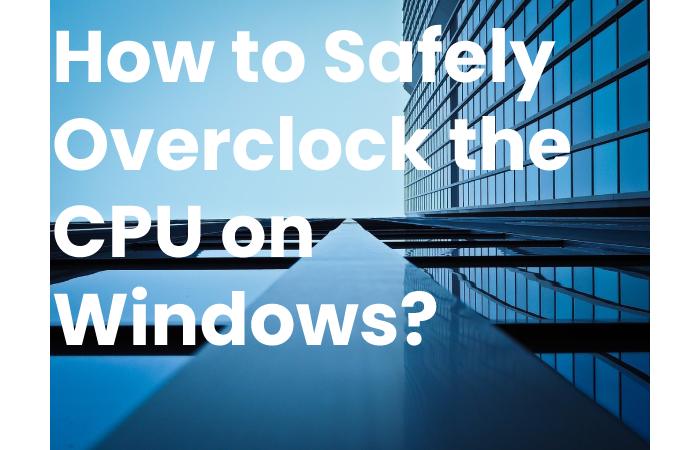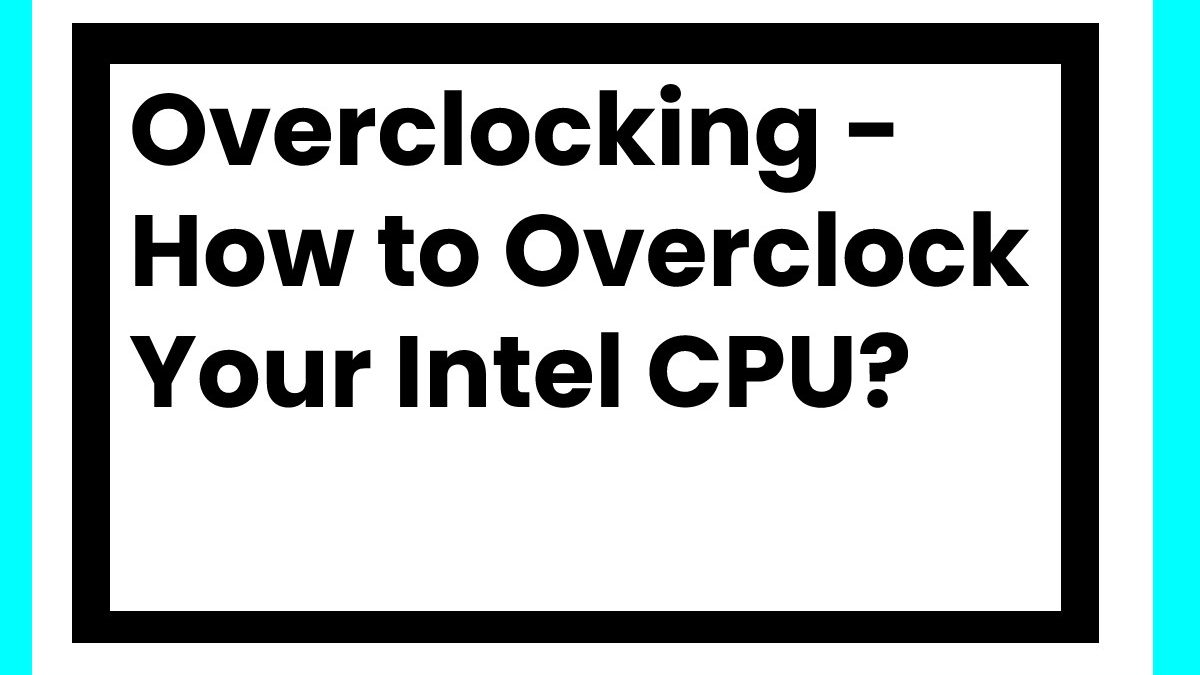Table of Contents
Overclocking
Overclocking is a part of PC tuning and refers to methods to increase the transmission or processing speed of clock-dependent components in a computer. As a rule, the clock rate increased to operate the components involved above their nominal clock.
You can overclock the processor, the memory bus of the main memory, and the graphics card. You can get the most significant performance gain by overclocking the processor. But, overclocking or overclocking falls into the field of PC handicrafts. It means that saving time through efficiency improvements must not play a role. The time you put in will not be recouped with a faster computer.
If you want to overclock, you have to familiarize yourself with how the hardware components involved work and interact. Benefits, risks, and side effects must determine precisely.
When attempting overclocking, it must always expect system components to be damaged or destroyed. Therefore, you should back up your data before overclocking. Better yet, try overclocking on a new system.
How to Safely Overclock the CPU on Windows?

Might you want to chip away at the presentation of your PC? Overclocking your focal processor is a helpful technique for making your PC run faster without spending a penny on an expensive redesign. It achieves by running your PC processor at a higher than arranged repeat. Examine on to sort out some way to push the processor beyond what many would consider possible, truly take a gander at the PC’s temperature, and achieve stable overclocking.
Can I Overclock my CPU?
Let’s start with the most complicated question: Can you overclock your CPU? Not every processor supports overclocking. In this case, the CPU has a so-called “open multiplier.”
You can derive relevant information from the name of the CPU, for example. Intel adds processors that can overclock, such as B. the Intel Core i7 9700K, add the letter “K.” Also, all processors from the Intel X series (mainly used for professional multimedia applications) can overclock.
In theory, any CPU can overclock. However, this can only achieve by increasing the so-called base clock. However, just because you can overclock a CPU doesn’t mean you should. Pushing the tech too far can cause CPU stability issues.
The following units explain how to use a system benchmark to measure the performance of your CPU. Stress test, check the temperature, and overclock!
Determine the core temperature of your CPU. Before you start, it is essential to check the temperature of your CPU as overclocking increases it. You should measure this temperature change.
Conduct a Stress Test
If you want to perform a noticeable CPU overclocking, you should subject your CPU to a stress test. You want to ensure that the current system is stable under the current default clock speed. If you run into problems later, you should also know why!
Check CPU Performance
To see improvement, you need to know your starting point! First, you should get an idea of the performance of your current CPU. A good tool for this task is Cinebench, which simulates a rendering workload. Extract the archive and start Cinebench Windows 64 bit.After launching Cinebench, click the Run button in the CPU section. When rendering is complete, the current score is displayed. Record this value for later comparison
Set the CPU Multiplier
The first step to increasing the clock speed should be to increase the multiplier. It uses the base clock specified in the motherboard (usually 100 MHz). Multiplying this number gives your clock speed. For example, a multiplier of 36 (x100MHz) gives you 3.6GHz.
Gradually increase the multiplier. It is usually done by typing the value or using the “+” key on the keyboard. Increase the matter slowly. To do this, do several passes. Increase the speed slightly. If all goes well, go back and keep accelerating.
Save your settings and reboot the system. Run stress tests and benchmarking to determine CPU stability and performance.
However, by overclocking the multiplier, you only get a relatively small increase in performance (from 36 to 39 in our case) without making things unstable. Your CPU needs a little more “juice” to get going.
Overclocking the Processor
After a CPU has been manufactured, it tests for its maximum possible clock frequency. Only then is it classified accordingly. Due to the relatively high demand for slower processors (cheaper), individual CPUs are often marked as dead, although they could run much faster. It opens up the scope for overclocking this processor. Unfortunately, you don’t know which processor can be overclocked by how much beforehand. More than one or two clock stages should rarely be possible.
Overclocking a processor means running it at a higher clock than the manufacturer intended.
In principle, however, whoever overclocks a processor endangers the processor. It proves that the service life of overclocked processors reduces.
One should not underestimate the time it takes to test the overclocked system. Nothing sucks more than having an overclocked processor cause trouble. Overclocked processors often ensure that power-saving technologies override. The additional power loss in the processor core when overclocking is also problematic. It leads to more significant heat generation. It means you have to provide additional cooling. Which in turn leads to higher power consumption and noise development. Attention, the PC power supply must be able to deliver more power.
Overclocking the Main Memory (Memory Modules)
Overclocking RAM is one of the complicated things to do. Because you have to ensure that the system then works stably and correctly, a memory error can lead to data loss and, in the worst case, destroy necessary operating system settings. Repairing such damage takes more time than the speed of the overclocked memory would bring.
The following Parameters do a Memory Module Faster:
transfer rate
timings
Number of memory Channels – Overclocking
The values of memory modules suitable for overclocking are usually outside the JEDEC specification. They have shorter latency times and allow higher frequencies, usually only with higher operating voltages. It puts a strain on the memory controller of the CPU or chipset and affects many electrical parameters of the memory system. With the higher operating voltage, the power consumption also increases, so you usually have to take care of additional cooling. However, most motherboards do not allow you to change the voltage for the memory modules. There are particular motherboards for overclockers. The motherboard and BIOS must be able to handle these memory modules. Otherwise, these memory modules only work with standard time parameters and do not offer advantages over standard DIMMs.
Overclocking – Normal Memory Chips
Normal memory chips are installed in the sometimes extremely expensive overlocker memory modules. Special memory modules are not necessary for overclocking. The colorful metal heat sinks and relatively thin metal sheets conceal which chips have been installed. As some think, they are primarily used for decoration and marketing and not for cooling.
Therefore, the influence of fast memory on the operating speed of a PC is overestimated. The advantage of overclocked memory is relatively slight. The rate increase will be felt in exceptional cases. Overclocking the main memory is useless without using memory-intensive applications. Only specific algorithms can benefit from faster memory. These mainly include scientific simulations.
In principle, you don’t need to worry about the speed of the RAM as long as it’s big enough. Upgrading with additional memory modules is a better way than overclocking the RAM. It recommends buying JEDEC-compliant standard DIMMs.
- More information about memory
- Designation of memory modules
- Overclocking the graphics card
The graphics card can usually overclock with additional tools or the graphics driver. Mostly even quite comfortably under Windows. As long as the power supply remains unchanged, nothing can happen. A miscalculation of the GPU leads at most to a display error that only has a short-term effect.
Nevertheless, caution also require here. Overclocking the graphics card can result in display problems and system crashes.
Conclusion
There are many detailed directions on the Internet under the term overclocking or overclocking. Occasionally, one also finds frequency records. They can only reach for a few seconds. And that only at low loads and nitrogen or helium cooling.
Subsequently, overclocking suggests working the hardware past the specific. Overclocking is an unsafe business for the processor, essentially for the whole PC system. Overclocking is only for trained professionals and specialists who comprehend what they’re doing. Along these lines, the assurance or affirmation doesn’t cover hurt achieved by overclocking.
Read Also : Deindexed by Google – Tips to Recover your Deindexed by Google


